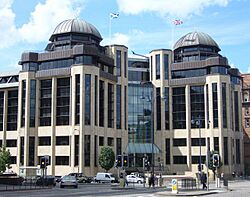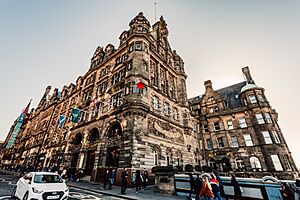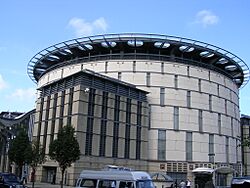Economy of Edinburgh facts for kids
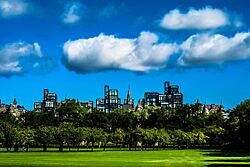
Quartermile, mixed use development including office space and retail units
|
|
| Currency | Pound Sterling (£) |
|---|---|
| Statistics | |
| Population | 523,000 (2022) |
| GDP | £31.8 billion (2022) |
|
GDP per capita
|
£60,764 (2022) |
|
GDP by sector
|
Financial services, banking, insurance, national government, local government, public sector, gaming, software development, hospitality, tourism |
|
Labour force
|
312,100 / 82.1% in employment (Jan 2023-Dec 2023) |
|
Labour force by occupation
|
List
40.8% Professional Occupations
19.4% Associate Professional Occupations 9.4% Managers, Directors And Senior Officials 7.5% Administrative & Secretarial Occupations 6.0% Sales And Customer Service Occs 5.4% Skilled Trades Occupations 4.9% Caring, Leisure And Other Service Occupations 4.8% Elementary Occupations 1.8% Process Plant & Machine Operatives (Jan–Dec 2023) |
| Unemployment | 10,900 / 3.5% (Jan 2023-Dec 20234) |
|
Average gross salary
|
£720.70 per week (2023) |
Edinburgh is the capital city of Scotland and a very important place for business! It's known as a major financial hub, not just in Scotland but also in the wider United Kingdom. In fact, it's the second biggest financial center in the UK, right after London.
The city has been one of the most successful parts of the country for a long time. It has the strongest economy of any UK city outside of London. Financial Times FDi Magazine even called Edinburgh the "Best Large European City of the Future" in 2012/13. This shows how important Edinburgh is for business and jobs.
Contents
Edinburgh's Economy: A Quick Look
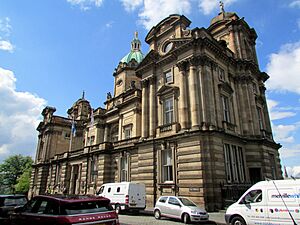
Edinburgh's economy is strong and diverse. It's a key part of the Scottish economy. Many people work here, making it a busy and important city.
Banking History and Financial Services
Banking has been a big part of Edinburgh's economy for over 300 years. The Bank of Scotland was started way back in 1695. Today, financial services are still super important. This includes banking, insurance, and investments.
Big companies like Scottish Widows and Standard Life Aberdeen are based here. This makes Edinburgh the UK's second-largest financial center. It's also the fourth largest in Europe for how much money it handles.
The NatWest Group (which used to be Royal Bank of Scotland Group) opened its main headquarters in Edinburgh in 2005. In the past, Edinburgh was famous for banking, publishing, printing, and making drinks. Now, it's mostly known for financial services, science, education, and tourism.
Key Numbers About Edinburgh's Economy
- In 2011, about 476,600 people lived in Edinburgh. This was a big increase from 2001.
- The city makes a lot of money per person, second only to London in major UK cities.
- Many people have jobs in Edinburgh. In 2013, about 73.6% of people who could work had jobs. This was higher than the rest of Scotland.
- Edinburgh also has a low number of people looking for jobs compared to other big UK cities.
- People in Edinburgh earn good salaries. In 2012, the average salary was about £27,800, second only to London.
Who Are the Biggest Employers?
Many different organizations provide jobs in Edinburgh. Here are some of the largest employers in the city:
| Employer | Number of employees |
|---|---|
| NHS Lothian | 19,890 |
| City of Edinburgh Council | 18,617 |
| University of Edinburgh | 13,372 |
| NatWest Group | 8,368 |
| Lloyds Banking Group | 7,500 |
| Standard Life | 5,259 |
| The Scottish Government | 3,913 |
| Lothian and Borders Police | 2,439 |
| Tesco (including Tesco Bank) | 2,400 |
| Royal Mail | 2,257 |
| colspan="8" style="text-align: left;" | Source: Edinburgh by Numbers 2013/14 |
This table shows how many people work in different types of jobs in Edinburgh:
| Sector | Number of employees |
|---|---|
| Human health and social work | 45,300 |
| Wholesale, retail and repair | 36,400 |
| Financial Services | 34,600 |
| Education | 29,200 |
| Accommodation and food services | 26,800 |
| Professional, scientific and technical activities | 27,100 |
| Administrative and support services activities | 21,000 |
| Public administration, defence and social security | 18,700 |
| Information and communication | 12,400 |
| Transportation and storage | 10,200 |
| Arts, entertainment and recreation | 10,000 |
| Construction | 9,000 |
| Manufacturing | 7,300 |
| Other service activities | 5,500 |
| Primary industries and utilities | 3,200 |
| Real estate | 5,200 |
| colspan="8" style="text-align: left;" | Source: Edinburgh by Numbers 2013/14 |
Important Industries in Edinburgh
Financial Services
Edinburgh is a huge center for financial services. It's the second biggest in the UK after London. It's also the fourth largest in Europe for how much money it manages.
Banking has been important here for over 300 years. The Bank of Scotland started in 1695. The Royal Bank of Scotland (RBS) began in 1727. Today, RBS is part of the NatWest Group, and its main office is in Edinburgh. Other banks like TSB, Tesco Bank, and Virgin Money also have their main offices here.
Insurance companies like Standard Life and Scottish Widows are also very big. They manage billions of pounds and employ many people. Many financial companies are located in the Exchange business district. This area is near Edinburgh Airport.
Edinburgh Park is one of the largest business parks in the UK. Many big companies like HSBC, Royal Bank, Diageo, and Lloyds Banking Group have offices there. Thousands of people work in this area.
Technology and Software
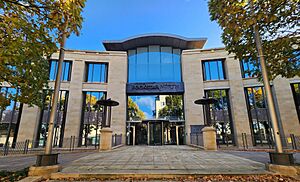
Edinburgh has a growing technology sector. Over 17,000 people work in digital companies here. This growth is thanks to the city's universities, which are great at teaching computer science.
More than 100 software companies are now in Edinburgh. This includes popular travel website Skyscanner and fantasy sports company FanDuel. Rockstar North, the company that makes the famous Grand Theft Auto games, is also based in Edinburgh. Big companies like Amazon and Microsoft have invested here too.
The School of Informatics at the University of Edinburgh is a top research group in computer science. It's known for its world-leading research. Many tech companies are located around the university.
Shopping and Retail
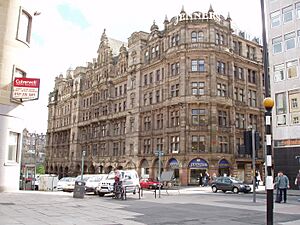
Edinburgh has many places to shop. There are big shopping centers like the Gyle and Fort Kinnaird. Other popular spots include Ocean Terminal in Leith and retail parks near the Edinburgh City Bypass.
In recent years, the city center's shopping scene has changed. The St. James Centre was rebuilt into the new St James Quarter. This huge new shopping area opened in 2021. It brought many new brands to the city. However, some shops on Princes Street moved to the new St James Quarter.
The St James Quarter was designed to look like an eye. The 5-star W Hotels is in the center of it. This new design caused some discussion because Edinburgh is a UNESCO World Heritage site.
Tourism
Tourism is a very important part of Edinburgh's economy. It supports about 30,000 jobs and brings in £1.6 billion to the city. In 2011, visitors spent over £1 billion here.
Edinburgh is Scotland's most popular place for tourists. More and more people visit each year. This is helped by Edinburgh Airport and good train links. The annual Edinburgh Festival and the Hogmanay (New Year) street party attract huge crowds. These festivals alone bring in over £100 million for the city.
Edinburgh is also a top place for business meetings and conferences in the UK. People love to visit Edinburgh's UNESCO World Heritage Sites, like the Old Town and New Town. Famous places like Edinburgh Castle and the Palace of Holyroodhouse also draw many visitors.
Here are some of the most visited tourist attractions in Edinburgh:
| Tourist attraction | Number of visitors | ||||||
|---|---|---|---|---|---|---|---|
| National Museum of Scotland | 1,893,500 | ||||||
| Edinburgh Castle | 1,230,200 | ||||||
| Scottish National Gallery | 961,300 | ||||||
| St Giles' Cathedral | 904,400 | ||||||
| Edinburgh Zoo | 810,900 | ||||||
| Royal Botanic Garden Edinburgh | 704,600 | ||||||
| Edinburgh Bus Tours | 511,400 | ||||||
| National War Museum | 492,700 | ||||||
| Scottish Parliament Visitor Centre | 345,100 | ||||||
| Our Dynamic Earth | 331,800 | ||||||
| Scottish National Portrait Gallery | 328,000 | ||||||
| Scottish National Gallery of Modern Art | 314,800 | ||||||
| Royal Yacht Britannia | 300,700 | ||||||
| Scottish Whisky Heritage Centre | 270,600 | ||||||
| Museum of Childhood | 237,500 | ||||||
| Source: Moffat Centre Visitor Attraction Monitor 2012 [1] | |||||||
Public Sector and Government Jobs
Edinburgh is the center of Scotland's government and legal system. This means many government offices and public agencies are located here. The High Court of Justiciary and other legal institutions are also in the city.
Because of this, many lawyers and legal firms have offices in Edinburgh. This has led to more jobs in the public sector. The City of Edinburgh Council and the National Health Service (NHS) are the two biggest employers in the city.
Education and Research
Edinburgh is a major center for education in the UK. The University of Edinburgh was founded in 1583. Now, there are three more big universities in the city. Education and academic research play a huge role in the city's economy.
These universities attract many students from other countries and from across the UK. In the 2021–22 school year, over 74,000 students were enrolled in Edinburgh's four universities.
| Institution | Number of students | International Students | Rest of the UK Students |
|---|---|---|---|
| University of Edinburgh | 41,250 | 18,050 | 11,900 |
| Edinburgh Napier University | 15,530 | 3,635 | 1,005 |
| Heriot-Watt University | 11,680 | 4,135 | 1,615 |
| Queen Margaret University | 6,250 | 1,185 | 750 |
| colspan="8" style="text-align: left;" | Source: Higher Education Statistics Agency 2021/22 |
The University of Edinburgh is a leader in medicine and law. It was also one of the first to teach artificial intelligence in Britain. Heriot-Watt University is good at science and engineering. Napier University focuses on computing, business, and creative subjects.
Edinburgh also has many private schools. About one in five school-aged children attend these schools.
Getting Around: Edinburgh's Transport
Edinburgh is connected to the world by Edinburgh Airport (EDI). In 2018, over 14 million passengers used the airport. This makes it the busiest airport in Scotland.
The main train station is Edinburgh Waverley railway station. Over 22 million people used it in 2011–12. The city also has a great bus service, Lothian Buses. They run over 70 routes, including direct links to the airport.
The Edinburgh Trams system has two phases. The first phase opened in 2014, connecting the airport to York Place. The second phase opened in 2023, extending the line to Newhaven in Leith. There are ideas for more tram lines in the future.
Challenges and Future Plans
Edinburgh is always looking to grow and improve.
City Development
Some older areas, like the waterfront in Granton and Leith, are being redeveloped. These new projects will include homes, shops, and businesses. This helps the city grow and provides more space for people and companies.
Urban Growth
Edinburgh is a relatively small city. It's surrounded by greenbelt land, which is protected from building. This means new developments, like offices at Edinburgh Park, have to be carefully planned. The city also works with nearby areas like Glasgow to help the economy grow even more.



